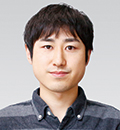Quantum Materials Field
Qubit Materials Group
We aim to develop solid-state materials for quantum science and technology to enhance quantum control and maximize quantum coherence.
Group Leader: Yusuke Kozuka
Electrostatically defined ZnO quantum dot for semiconductor qubits
Current Topics
Among various physical systems to realize quantum computers, semiconductor qubits have an advantage of high-density integration and high controllability. Recently, semiconductor qubits based on Si have been intensively studied because of the low nuclear spin density. However, the multi-valley conduction band structure inherent in Si has been found to be disadvantage for the electrons to be randomly placed in one of the valleys, deteriorating the controllability. We are focusing on potentially better materials to overcome such obstacle towards realization of highly integrated semiconductor qubits.
Outline of Research
We have demonstrated electrostatically defined quantum dot using ZnO heterostructure (Fig. 1). Semiconductor quantum dots are promising media for integrated quantum bits, but the existence of nuclear spins and multi-valley states are known to deteriorate the performance in conventional semiconductors such as Si and GaAs. In this respect, ZnO is considered as an ideal platform because of the low nuclear spin density and single valley nature. Our result opens a way to fabricate semiconductor qubits based on ZnO for the first time and points out a high potential of this material for quantum devices [1].

Fig. 1. Scanning electron microscope image image of the ZnO quantum dot.
References
- K. Noro et al., Nature Commun. 15 , 9556 (2024). DOI: 10.1038/s41467-024-53890-2
Group members
-
 Yusuke Kozuka・Group Leader
Yusuke Kozuka・Group Leader -
 Hiroshi Oike・Senior Researcher
Hiroshi Oike・Senior Researcher -
 Takuya Iwasaki・Independent Researcher
Takuya Iwasaki・Independent Researcher
Links


